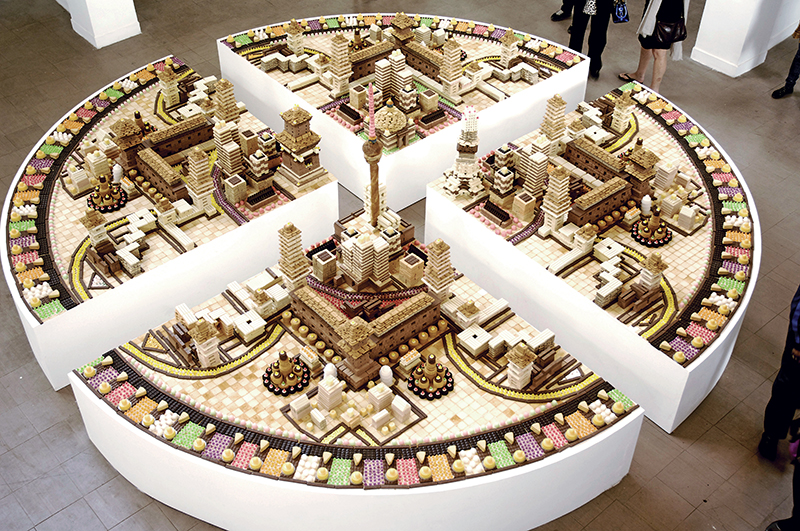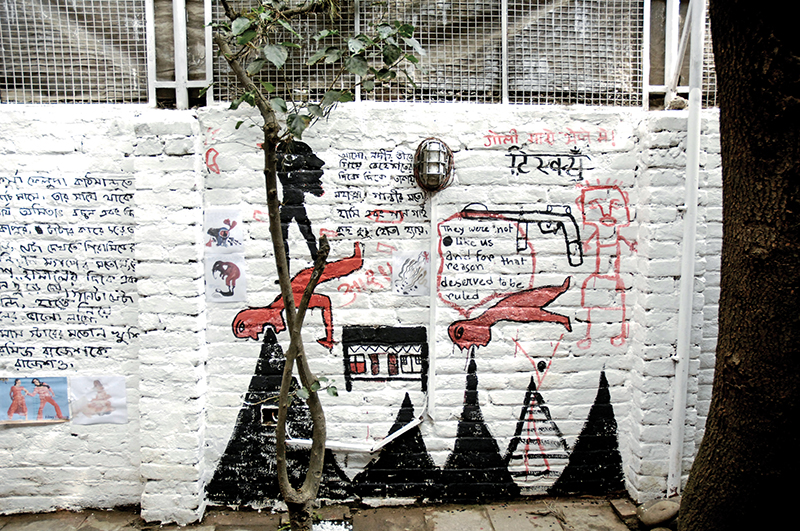Flavours of the City
Kathmandu
The Kathmandu Triennale (KT) 2017 is in full swing and it is a galore of contemporary art. There is an array of exhibitions, performance art, installation art, murals, film screening alongside symposiums, master classes and encounters where art enthusiasts are thriving along with the art.
From conceptual art of Peter Downsbrough (USA) where he has made minimal interventions with works like ‘here, then’ and lines on postcards from Kathmandu to simple chalk drawings and their photographs in various cities and villages of Bart Lodewijks (Netherlands) to delicious mandala art of Chinese artist Song Dong and Karan Shrestha’s enquiries about consumerism in Kathmandu, there is more from artists from more than 25 countries at KT 2017, that opened on March 24.
But one thing is common in them — The City: My Studio / The City: My Life, which is KT’s theme and ‘The City’ has been illustrated in different perspectives of the artists.
“City is a logical theme,” shared curator of KT 2017 Philippe Van Cauteren. “I like city, I like to live in city and I like to visit cities. Because city is kind of a little cosmos where everything happens on a little scale and it is very layered. You have things to refer to history, present things and most changes and innovations are happening in cities. In artists’ terms, most artistic revolutions were happening in cities and not countryside. It is a logical place for artists.”
KT 2017, in its inaugural edition, invited artists from around the globe to come without any artwork, but to make one here in Kathmandu. Cauteren added, “Kathmandu is not an illustration but a platform; the flavour of KTM is present in the exhibition.”
The chalk drawings by artist Lodewijks connects 14 cities and villages — Kent, Glasgow, Rio de Janeiro, Brussles and Kathmandu to name a few through the photographs hung on the walls of Nepal Art Council with “chalk art of straight lines” in a story.
“The art has strong identity — they are straight lines, all kinds of combination of straight lines. The work is about chalk and trust. I can’t draw without chalk and I can’t draw without the trust of people,” shared the artist who started abstract art 17 years ago and he has drawn in “low class” neighbourhood.
“Chalk is the best medium to connect, because of the chalk and trust concept — while working precisely that is what people see and not art. Doing your work seriously and precisely, that is what people take back.”
Kathmandu makes the central theme of Shrestha’s ‘Everything at the Centre is little off’ at Taragaon Museum, Bouddha.
“Kathmandu is the centre of Nepal; geographically it is off-centre. Kathmandu being a Valley has no horizon. No horizon means there is no looking out and this basically dictates our all movement,” he said of his works which include video projection, video screening and sculpture. As per him, there is consumerism and garbage in Kathmandu Valley and people are doing nothing.
He feels, “If art makes sense, it passes through human consciousness and we make a certain enquiry. I think this enquiry is important to share things. It is about feeling and about responding to certain things. Otherwise we won’t talk of anything.”
Artist from Bangladesh Mahbubur Rahman has too explored Kathmandu City and its third gender to “give a new perspective, which is different from ours”.
In this project, he has “shown existence” of 38-year-old Tirtha Man Shakya from Kirtipur. The artist has showcased Shakya’s two lifestyles — married life with his family; and as a transgender — through videos and by recreating Shakya’s room (where he transforms himself into woman) at Nepal Art Council.
Dong has given an imaginary city to KT 2017 — a monumental mandala of Kathmandu City with chocolates, jellies and cookies that he took five days
to make.
The Triennale has some fantastic concepts in the form of art. The preparation started one-and-a-half years ago where the featuring artists stayed in Kathmandu as long as one month to five days prior to the exhibition to come up with their new works.
“We really embraced the whole idea of taking the city as a workplace where there is a kind of interaction between artists’ life, activities and engagements of the artist over the city,” Cauteren expressed.
Belu-Simion Fainaru from Israel created his work from materials he got in Nepal — cutlery and filled them with black-coloured liquid to depict contamination.
“It is my first time here and I wanted to know about the City. I travelled in bus collecting things. I connected and interacted with local people and artists here,” he shared about his experience adding, “It was difficult because of the language and culture. But I feel comfortable and safe as people are open and make you feel comfortable and the place gives positive energy.”
Other than the central exhibition, there are other features at KT 2017 including collateral exhibition. ‘Upheavals’ by Bengal Foundation is one of them where eight artistes of three different generations have expressed Bangladesh now as seen by them.
As per one of the curators Tanzim Wahab, “Bangladesh has a post-colonial history and a war with Pakistan, it is a pretty new country. So, we went a lot through different issues like environmental issues, urbanisation and various questions about the identity in post colonial situation. So, we are inviting the artists — who are discussing the critical aftermath of colonisation and how we are evolving and developed — to show their works by keeping ‘The City’ in perspective.”
There are mix-media artwork, interdisciplinary artwork, video installations, drawing and some experimental photographic works.
“Upheaval is something that comes and changes the situation that was. Bangladesh’s history is very much based on the succession of disruption, violent changes that happened quickly and completely reshaped the order — older order that is being shaken to produce a new order. We found it interesting to analyse the response of artists to the concept upheaval,” added another curator Hadrien Diez.
The Triennale is on till April 9.







